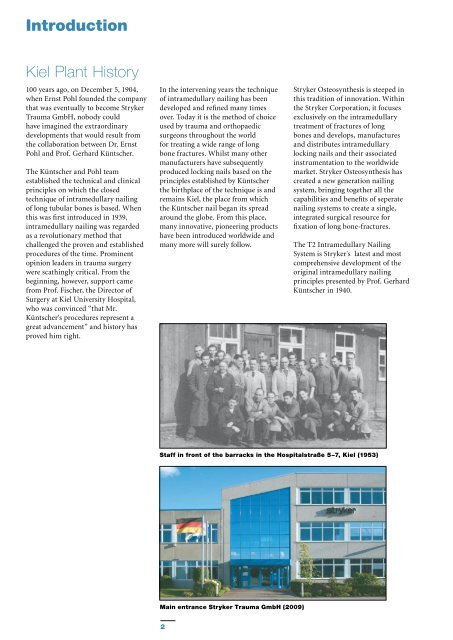Create successful ePaper yourself
Turn your PDF publications into a flip-book with our unique Google optimized e-Paper software.
Introduction<br />
Kiel Plant History<br />
100 years ago, on December 5, 1904,<br />
when Ernst Pohl founded the company<br />
that was eventually to become <strong>Stryker</strong><br />
Trauma GmbH, nobody could<br />
have imagined the extraordinary<br />
developments that would result from<br />
the collaboration between Dr. Ernst<br />
Pohl and Prof. Gerhard Küntscher.<br />
The Küntscher and Pohl team<br />
established the technical and clinical<br />
principles on which the closed<br />
technique of intramedullary nailing<br />
of long tubular bones is based. When<br />
this was first introduced in 1939,<br />
intramedullary nailing was regarded<br />
as a revolutionary method that<br />
challenged the proven and established<br />
procedures of the time. Prominent<br />
opinion leaders in trauma surgery<br />
were scathingly critical. From the<br />
beginning, however, support came<br />
from Prof. Fischer, the Director of<br />
Surgery at Kiel University Hospital,<br />
who was convinced “that Mr.<br />
Küntscher‘s procedures represent a<br />
great advancement” and history has<br />
proved him right.<br />
In the intervening years the technique<br />
of intramedullary nailing has been<br />
developed and refined many times<br />
over. Today it is the method of choice<br />
used by trauma and orthopaedic<br />
surgeons throughout the world<br />
for treating a wide range of long<br />
bone fractures. Whilst many other<br />
manufacturers have subsequently<br />
produced locking nails based on the<br />
principles established by Küntscher<br />
the birthplace of the technique is and<br />
remains Kiel, the place from which<br />
the Küntscher nail began its spread<br />
around the globe. From this place,<br />
many innovative, pioneering products<br />
have been introduced worldwide and<br />
many more will surely follow.<br />
Staff in front of the barracks in the Hospitalstraße 5−7, Kiel (1953)<br />
Main entrance <strong>Stryker</strong> Trauma GmbH (2009)<br />
2<br />
<strong>Stryker</strong> Osteosynthesis is steeped in<br />
this tradition of innovation. Within<br />
the <strong>Stryker</strong> Corporation, it focuses<br />
exclusively on the intramedullary<br />
treatment of fractures of long<br />
bones and develops, manufactures<br />
and distributes intramedullary<br />
locking nails and their associated<br />
instrumentation to the worldwide<br />
market. <strong>Stryker</strong> Osteosynthesis has<br />
created a new generation nailing<br />
system, bringing together all the<br />
capabilities and benefits of seperate<br />
nailing systems to create a single,<br />
integrated surgical resource for<br />
fixation of long bone-fractures.<br />
The <strong>T2</strong> Intramedullary Nailing<br />
System is <strong>Stryker</strong>´s latest and most<br />
comprehensive development of the<br />
original intramedullary nailing<br />
principles presented by Prof. Gerhard<br />
Küntscher in 1940.

















